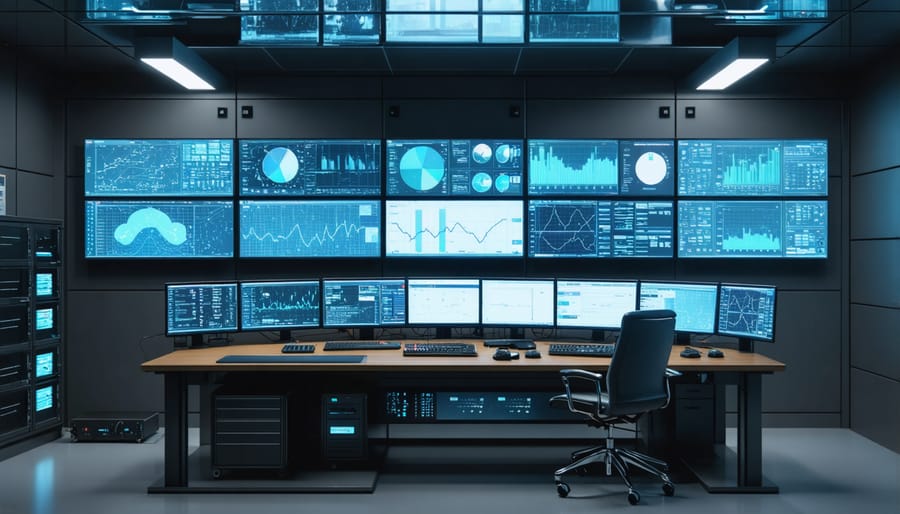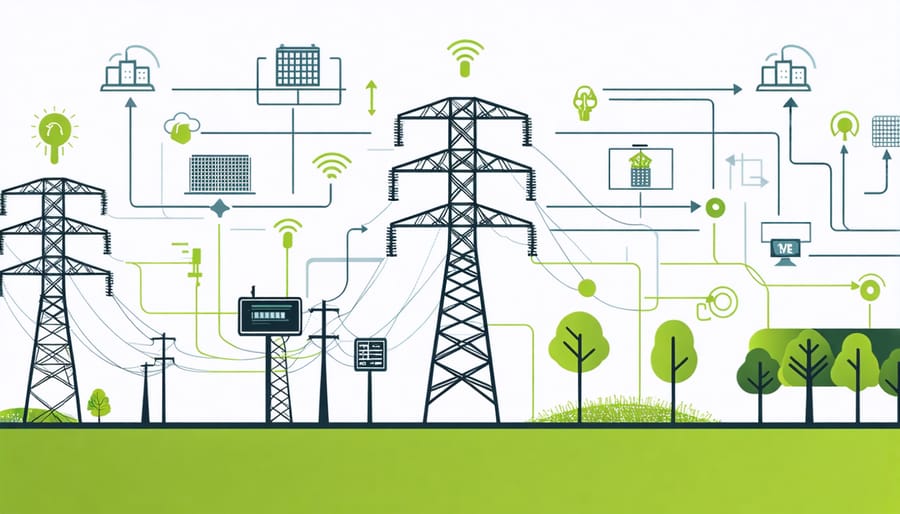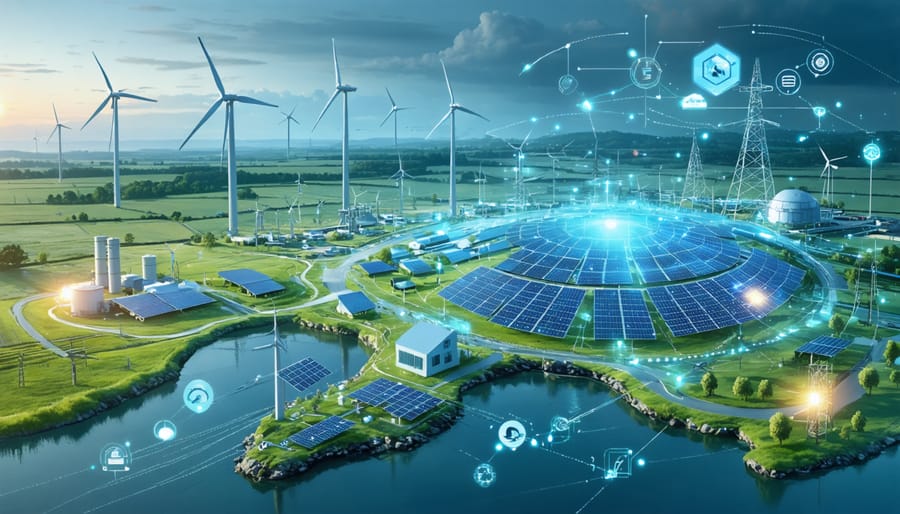Energy infrastructure forms the backbone of modern civilization, encompassing a vast network of physical assets, digital systems, and operational frameworks that power our world. From traditional power plants and modern power grid systems to renewable energy installations and distribution networks, this critical infrastructure represents one of humanity’s most complex and essential engineering achievements. As nations transition toward sustainable energy solutions and face evolving security challenges, understanding the interconnected components of energy infrastructure becomes increasingly vital for industry professionals.
The convergence of physical and digital systems has transformed traditional energy infrastructure into a sophisticated ecosystem where power generation, transmission, distribution, and consumption are monitored and controlled through advanced technological solutions. This integration enables unprecedented efficiency and reliability but also introduces new vulnerabilities that demand robust security measures and innovative management strategies. For construction professionals and industry stakeholders, comprehending these systems’ complexities is crucial for developing, maintaining, and securing the energy frameworks that power our future.

Core Components of Energy Infrastructure
Generation Facilities
Generation facilities form the cornerstone of energy infrastructure, encompassing a diverse array of power production installations. Traditional thermal power plants, including coal-fired, natural gas, and nuclear facilities, continue to provide baseload power generation through sophisticated steam turbine systems and extensive cooling mechanisms. These facilities require robust supporting infrastructure, including fuel storage, emissions control systems, and comprehensive safety protocols.
Renewable energy installations have become increasingly prominent, featuring utility-scale solar farms with photovoltaic arrays, wind farms with both onshore and offshore turbines, and hydroelectric facilities integrated with dam systems. Modern biomass plants and geothermal facilities supplement these renewable sources, contributing to a more diversified energy portfolio.
Distributed generation sources, such as combined heat and power (CHP) plants and small-scale renewable installations, are gaining importance in the energy landscape. These facilities often incorporate advanced monitoring systems, smart grid integration capabilities, and energy storage solutions to enhance grid stability and efficiency. The integration of these various generation sources requires sophisticated control systems and infrastructure to maintain reliable power supply while managing fluctuating demand patterns.
Transmission Networks
Transmission networks form the backbone of modern energy infrastructure, consisting of high-voltage power lines that transport electricity from generation facilities to distribution points. These networks typically operate at voltages ranging from 69kV to 765kV, enabling efficient long-distance power transmission while minimizing energy losses. The system includes critical components such as transformers, substations, and switchgear that regulate voltage levels and control power flow.
Modern transmission infrastructure incorporates advanced monitoring systems, including SCADA (Supervisory Control and Data Acquisition) technology, which enables real-time management and response to system changes. Substations serve as crucial nodes, housing equipment for voltage transformation, circuit protection, and power routing. These facilities utilize sophisticated protection systems, including circuit breakers, surge arresters, and relay devices to maintain grid stability and prevent cascading failures.
The design and maintenance of transmission networks must account for environmental factors, load requirements, and redundancy needs to ensure reliable power delivery while meeting increasing demand for electricity distribution.
Distribution Systems
Distribution systems form the critical final link in energy delivery, connecting high-voltage transmission lines to end users through power distribution networks. These systems typically operate at medium to low voltage levels and comprise transformers, substations, and local distribution lines that serve residential, commercial, and industrial consumers. Modern distribution infrastructure incorporates advanced metering systems, voltage regulators, and automated switching equipment to maintain reliable service delivery.
The architecture of distribution systems varies by region and population density, with urban areas featuring complex underground networks and rural regions relying more on overhead lines. Key components include distribution transformers that step down voltage for safe consumer use, protective devices that prevent system overload, and smart meters that enable real-time consumption monitoring and dynamic load management.
Integration of distributed energy resources, such as solar panels and energy storage systems, has introduced new complexities to distribution system design and operation, requiring sophisticated control systems and enhanced cybersecurity measures.
Digital Layer of Modern Energy Infrastructure
SCADA Systems
SCADA (Supervisory Control and Data Acquisition) systems form the operational backbone of modern energy infrastructure, enabling real-time monitoring and control of critical assets across power generation, transmission, and distribution networks. These sophisticated systems collect data from thousands of sensors and control points, providing operators with comprehensive visibility into infrastructure performance and system status.
In energy facilities, SCADA systems manage crucial functions including power flow control, load balancing, fault detection, and emergency response protocols. They integrate various components such as Remote Terminal Units (RTUs), Programmable Logic Controllers (PLCs), and Human-Machine Interfaces (HMIs) to create a unified control environment.
The importance of SCADA systems extends beyond basic monitoring and control. They enable predictive maintenance, optimize resource allocation, and enhance operational efficiency through advanced analytics and automation. Modern SCADA implementations also facilitate integration with smart grid technologies, enabling dynamic response to changing energy demands and grid conditions.
However, as these systems become more interconnected, cybersecurity considerations have become paramount. Energy providers must implement robust security measures to protect SCADA networks from potential cyber threats while maintaining operational reliability and system performance. Regular updates, security audits, and staff training are essential components of SCADA system management.

Smart Grid Technologies
Modern smart grid technologies represent a revolutionary advancement in energy infrastructure, integrating digital communications with power distribution systems to enable real-time monitoring and control. Advanced Metering Infrastructure (AMI) serves as the cornerstone of this transformation, replacing traditional meters with smart meters that provide bidirectional communication between utilities and consumers.
Grid automation systems enhance operational efficiency through sophisticated control mechanisms, including automated switches, fault detectors, and voltage regulators. These components work in concert to enable self-healing capabilities, automatically isolating faults and rerouting power to minimize outages and service disruptions.
The implementation of distributed energy resource management systems (DERMS) allows for seamless integration of renewable energy sources, energy storage systems, and demand response programs. This advanced infrastructure utilizes artificial intelligence and machine learning algorithms to optimize power flow, predict maintenance needs, and balance supply with demand in real-time.
For construction professionals and system integrators, understanding these technologies is crucial as they increasingly become standard requirements in new building projects and infrastructure upgrades. The integration of these systems requires careful consideration of cybersecurity protocols and physical infrastructure requirements to ensure reliable and secure operation.

Industrial Control Systems
Industrial Control Systems (ICS) form the operational backbone of modern energy infrastructure, integrating sophisticated hardware and software to manage critical processes. These systems encompass Supervisory Control and Data Acquisition (SCADA), Distributed Control Systems (DCS), and Programmable Logic Controllers (PLCs), working in concert to monitor and control energy generation, transmission, and distribution.
At the heart of these systems, SCADA networks provide real-time monitoring and control capabilities, enabling operators to oversee vast networks of power plants, substations, and distribution facilities from centralized control rooms. DCS components manage localized processes within specific facilities, while PLCs handle automated control functions at the equipment level.
These control systems are increasingly interconnected through industrial networks, allowing for enhanced efficiency and remote operation capabilities. Modern ICS implementations incorporate advanced features such as predictive maintenance, automated fault detection, and dynamic load balancing. However, this connectivity also necessitates robust cybersecurity measures to protect against potential threats and ensure continuous operation of critical energy services.
The integration of traditional operational technology with modern IT systems has created smart grid capabilities, enabling more efficient energy management and rapid response to system changes or emergencies.
Integration Points and Vulnerabilities
Physical-Digital Interfaces
Modern energy infrastructure operates at the critical intersection of physical assets and digital control systems, creating a sophisticated network that demands careful integration and management. These physical-digital interfaces, often called operational technology (OT) systems, serve as the nervous system of energy infrastructure, connecting traditional hardware components with advanced digital controls.
SCADA (Supervisory Control and Data Acquisition) systems represent the primary bridge between physical infrastructure and digital management, enabling real-time monitoring and control of power generation, transmission, and distribution systems. Smart meters, sensors, and automated switches form the peripheral nodes of this network, collecting crucial operational data and executing commands from central control systems.
The integration of Industrial Internet of Things (IIoT) devices has further enhanced this interface, allowing for predictive maintenance, dynamic load balancing, and improved grid resilience. These systems process millions of data points daily, enabling operators to optimize energy flow, respond to demand fluctuations, and manage system failures effectively.
However, this convergence of physical and digital systems creates unique challenges. Cybersecurity becomes paramount as digital access points could potentially compromise physical infrastructure. Modern energy facilities must implement robust security protocols that protect both digital systems and physical assets while maintaining operational efficiency. This includes implementing air-gapped networks, multi-factor authentication, and regular security audits to ensure system integrity.
Network Architecture
Modern energy infrastructure relies heavily on sophisticated communication networks that enable real-time monitoring, control, and optimization of energy systems. These networks form the backbone of smart grids, connecting various components from power generation facilities to distribution endpoints through a hierarchical architecture.
At the core, industrial control systems (ICS) and supervisory control and data acquisition (SCADA) systems manage the operational technology (OT) network. These systems communicate through specialized protocols such as Modbus, DNP3, and IEC 61850, which are designed specifically for power system automation and control.
The network architecture typically consists of three main layers: the field network, connecting sensors and actuators; the control network, managing substations and local operations; and the corporate network, handling business operations and enterprise-level decisions. Advanced metering infrastructure (AMI) systems form an additional layer, enabling two-way communication between utilities and end-users.
Fiber-optic cables serve as the primary medium for high-speed, secure communication between major infrastructure components, while wireless technologies like cellular networks and RF mesh systems provide flexibility for last-mile connectivity. Software-defined networking (SDN) is increasingly being adopted to enhance network management and security.
To ensure reliability and resilience, these networks incorporate redundant communication paths, fail-safe mechanisms, and cybersecurity measures such as encryption, authentication protocols, and network segmentation. This comprehensive network architecture enables efficient energy distribution while maintaining system security and operational stability.
Future Developments and Challenges
The energy infrastructure landscape is rapidly evolving, driven by technological advancements, environmental concerns, and evolving infrastructure requirements. Key developments include the integration of smart grid technologies, renewable energy systems, and advanced energy storage solutions. These innovations are reshaping how we generate, distribute, and consume energy, while simultaneously introducing new challenges that industry professionals must address.
Cybersecurity has emerged as a critical concern, particularly as energy systems become increasingly digitized and interconnected. The integration of Internet of Things (IoT) devices and automated control systems, while improving efficiency, creates potential vulnerabilities that require robust security protocols and continuous monitoring.
Climate resilience is another crucial factor shaping future developments. Infrastructure must be designed and upgraded to withstand extreme weather events, rising sea levels, and other climate-related challenges. This necessitates innovative engineering solutions and adaptive design strategies that can ensure system reliability under varying environmental conditions.
The transition to renewable energy sources presents both opportunities and challenges. While solar, wind, and other renewable technologies become more cost-effective, their integration into existing grid systems requires significant infrastructure modifications. Energy storage solutions, including advanced battery systems and pumped hydro storage, are becoming essential components in managing intermittent renewable power generation.
Investment in workforce development is crucial as the sector becomes more technologically sophisticated. Engineers and technicians must be trained in new technologies while maintaining expertise in traditional systems. This dual requirement creates a pressing need for comprehensive training programs and updated industry certifications.
Looking ahead, the industry must balance the imperative for modernization with cost considerations and reliability requirements. Successful infrastructure development will require collaboration between public and private sectors, innovative financing mechanisms, and careful planning to ensure system resilience while maintaining affordability for end-users.
Understanding energy infrastructure is crucial for modern construction professionals and cybersecurity specialists alike. As we’ve explored throughout this article, energy infrastructure encompasses a complex network of physical assets, digital systems, and operational technologies that work together to power our world. The integration of smart technologies and IoT devices has transformed traditional power systems into sophisticated cyber-physical networks, creating both opportunities and challenges.
The interconnected nature of modern energy infrastructure demands a holistic approach to security and management. Construction professionals must recognize that every component, from power generation facilities to distribution networks, plays a vital role in the overall system’s resilience. The increasing digitalization of energy systems means that cybersecurity considerations must be incorporated from the earliest stages of infrastructure planning and development.
Looking ahead, the evolution of energy infrastructure will continue to accelerate, driven by renewable energy integration, grid modernization, and emerging technologies. Professionals in the construction industry must stay informed about both physical infrastructure requirements and cybersecurity best practices to ensure the development of robust, secure energy systems.
By maintaining a comprehensive understanding of energy infrastructure components, vulnerabilities, and protection strategies, industry stakeholders can better contribute to building and maintaining resilient power systems that meet the demands of our digital age while maintaining the highest security standards.

